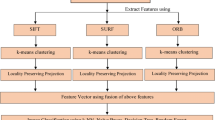Abstract
A new method for combining shape descriptors based on a behavior study from a learning set is proposed in this paper. Each descriptor is applied on several clusters of objects or symbols. For each cluster and for any descriptor a pertinent map is directly carried out from the learning database. Then existing conflicts are assessed and integrated in such a map. At last, we show that the use of combination of descriptors enables to improve the recognition using real data.
Similar content being viewed by others
References
Arya S., Mount D.M., Netanyahu N.S., Silverman R., Wu A. (1998): An optimal algorithm for approximate nearest neighbor searching. J ACM 45, 891–923
Ballard D.H. (1981): Generalizing the Hough transform to detect arbitary shapes. Pattern Recognit. 13(2): 111–122
Bamieh R., de Figueiredo R. (1986): A general moments invariants/attributed graph method for the three dimensional object recognition from a single image. IEEE J. Robotics Autom. 2, 240–242
Bhattacharya, A.: On a measures of divergence between two statistical populations defined by their probability distributions. Bull. Calculus Math Soc. 99–109 (1943)
Belkasim S.O., Shridar M., Ahmadi M. (1991): Pattern recognition with moment invariants: a comparative study and new results. Pattern Recognit. 24, 1117–1138
Bernier T., Landry J-A. (2003): A new method for representing and matching shapes of natural objects. Pattern Recognit. 36(8): 1711–1723
Cordella L.P., Vento M. (2000): Symbol recognition in documents: a collection of techniques? Int. J. Doc. Anal. and Recognit. 3(2): 73–88
Deans S.R. (1983): Applications of the Radon Transform. Wiley Interscience, New York
Derrode S., Ghorbel F. (2001): Robust and efficient Fourier– Mellin transform approximations for invariant grey-level image description and reconstruction. Comput. Vis. Image . 84(1): 25–39
Gevers T., Smeulders A.W.M. (1999): Context-based image retieval by viewpoint-invariant color indexing. Image Vis. Comput. 17, 475–488
Ghorbel F. (1994): A complete invariant description for gray-level images by the harmonic analysis approach. Pattern Recognit. Lett. 15, 1043–1051
Jain A.K., Duin R.P.W., Mao J. (2000): Statistical pattern recognition: a review. IEEE Trans. Pattern Anal. Mach. Intell. 22(1): 4–37
Kassim A.A., Tan T., Tan K.H. (1999): A comparative study of efficient generalised Hough transform techniques. Image Vis. Comput. 17, 737–748
Kauppinen H., Seppanen T., Pietikainen M. (1995): An experimental comparison of autoregressive and Fourier-based descriptors in 2D shape classification. IEEE Trans. Pattern Anal. Mach. Intell. 17(2): 201–207
Khotanzad, A., Lu, J.: Classification of invariant image representation using a neural network. IEEE Trans. Acoust. Speech Signal Process. pp. 1028–1190 (1990)
Khotanzad A., Hong Y.H. (1990): Invariant image recognition by Zernike moments. IEEE Trans. Pattern Anal. Mach. Intell. 12(5): 489–497
Loncaric S. (1998): A survey of shape analysis techniques. Pattern Recognit. 31(8): 983–1001
Persoon E., Fu K. (1977): Shape discrimination using Fourier descriptors. IEEE Trans. Syst. Man Cybern. 7(3): 170–179
Rubner Y., Tomasi S. (2000): Perceptual metrics for image database navigation. Kluwer, Boston
Rui, Y., She, A., Huang, T.S.: A modified Fourier descriptor for shape matching in MARS. Image Databases Multimedia Search, (ed.) S. K. Chang 8, 165–180 (1998)
Sharvit, D., Chan, J., Tek, H., Kimia, B.: Symmetry-based indexing of image databases. J. Vis. Commun. Image Represent. 12, (1998)
Tabbone, S., Wendling, L.: Binary shape normalization using the Radon transform. In: Discrete Geometry for Computer Imagery (DGCI). LNCS, vol. 2886, pp. 184–193. Naples, Italy (2003)
Teag R. (1980): Image analysis via the general theory of moments. J. Optical Soc. Am. 70(8): 920–921
Wood J. (1996): Invariant pattern recognition: a review. Pattern Recognit. 29(1): 1–17
Zhang D., Lu G. (2002): Shape-based image retrieval using generic Fourier desciptor, Signal Process. Image Commun. 17, 825–848
Zhang D., Lu G. (2004): Review of shape representation and description techniques. Pattern Recognit. 37(1): 1–19
Author information
Authors and Affiliations
Corresponding author
Rights and permissions
About this article
Cite this article
Salmon, J.P., Wendling, L. & Tabbone, S. Improving the recognition by integrating the combination of descriptors. IJDAR 9, 3–12 (2007). https://doi.org/10.1007/s10032-006-0034-9
Received:
Revised:
Accepted:
Published:
Issue Date:
DOI: https://doi.org/10.1007/s10032-006-0034-9




